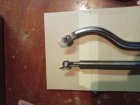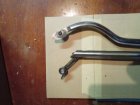Michael, The hope system has a cutter where you can put it on the Hope straight tool and rotate it to any angle, not just 45 degrees. It will function the same as the Jamison with the cutter at 45 degrees in a straight bar. As far as counter acting torque, articulate arm systems are different. The Hope system uses an I” (may be larger) post the arm fits over to counter act the torque where the Jamison is captured. Would be hard to say which is “better”, but both work well.
Attached is what I mean by "45 degrees". The first photo shows the Jamieson pivoting head inserted in a hole parallel to the shaft. This is equivalent to the Hope straight tool. The second shows it inserted in the 45 degree hole for extra reach.


